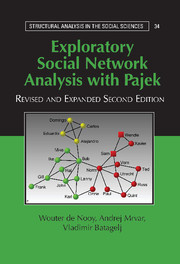Book contents
- Frontmatter
- Contents
- Figures
- Tables
- Preface to the Second Edition
- Preface to the First Edition
- Part I Fundamentals
- Part II Cohesion
- Part III Brokerage
- 6 Center and Periphery
- 7 Brokers and Bridges
- 8 Diffusion
- Part IV Ranking
- Part V Roles
- Appendix 1 Getting Started with Pajek
- Appendix 2 Exporting Visualizations
- Appendix 3 Shortcut Key Combinations
- Glossary
- Index of Pajek and R Commands
- Subject Index
8 - Diffusion
from Part III - Brokerage
Published online by Cambridge University Press: 05 June 2012
- Frontmatter
- Contents
- Figures
- Tables
- Preface to the Second Edition
- Preface to the First Edition
- Part I Fundamentals
- Part II Cohesion
- Part III Brokerage
- 6 Center and Periphery
- 7 Brokers and Bridges
- 8 Diffusion
- Part IV Ranking
- Part V Roles
- Appendix 1 Getting Started with Pajek
- Appendix 2 Exporting Visualizations
- Appendix 3 Shortcut Key Combinations
- Glossary
- Index of Pajek and R Commands
- Subject Index
Summary
Diffusion is an important social process. Administrators are interested in the diffusion of information and opinions, manufacturers seek the adoption of new techniques and products, and all of us have a vivid interest in not acquiring contagious diseases. Diffusion processes are being studied in the communication sciences, social psychology and sociology, public administration, marketing, and epidemiology.
In this chapter, we present diffusion processes from a network point of view. Diffusion is a special case of brokerage, namely, brokerage with a time dimension. Something – a disease, product, opinion, or attitude – is handed over from one person to another in the course of time. We assume that social relations are instrumental to the diffusion process: They are channels of social contagion and persuasion.
If personal contacts are important, then the structure of personal ties is relevant to the diffusion process and not just the personal characteristics that make one person more open to innovations than another. We investigate the relation between structural positions of actors and the moment at which they adopt an innovation.
- Type
- Chapter
- Information
- Exploratory Social Network Analysis with Pajek , pp. 186 - 212Publisher: Cambridge University PressPrint publication year: 2011

